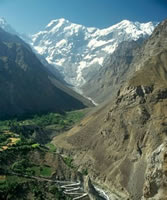AZAD JAMMU & KASHMIR

The State of Azad Kashmir (Liberated Kashmir), is part of the Pakistani administered section of the state of Jammu and Kashmir, along with the Northern Areas; its official name is Azad Jammu and Kashmir. It covers an area of 13,300 km² (5,135 mi²), with its capital at Muzaffarabad, and has an estimated population of almost 4 million people. Azad Kashmir has been considered politically, constitutionally and geographically as part of a separate state, i.e. Jammu & Kashmir . The said state is disputed territory and has been controlled by both Pakistan and India, since their independence, 14 / 15th August 1947, respectively. Azad Kashmir is under the indirect control of Pakistan and its area is known as Azad Jammu & Kashmir. Its defence, foreign policy and currency are the matters, which are under the direct control of Pakistan. Consequently, the financial matter, i.e. budget and tax affairs have been dealt with Azad Jammu & Kashmir Council, instead of Central Board of Revenue
















